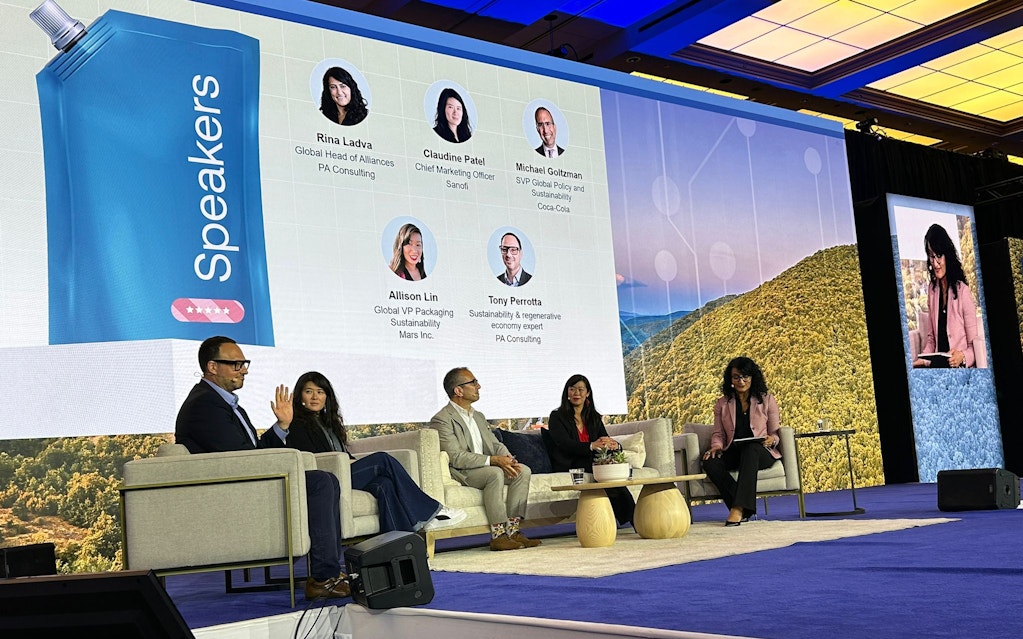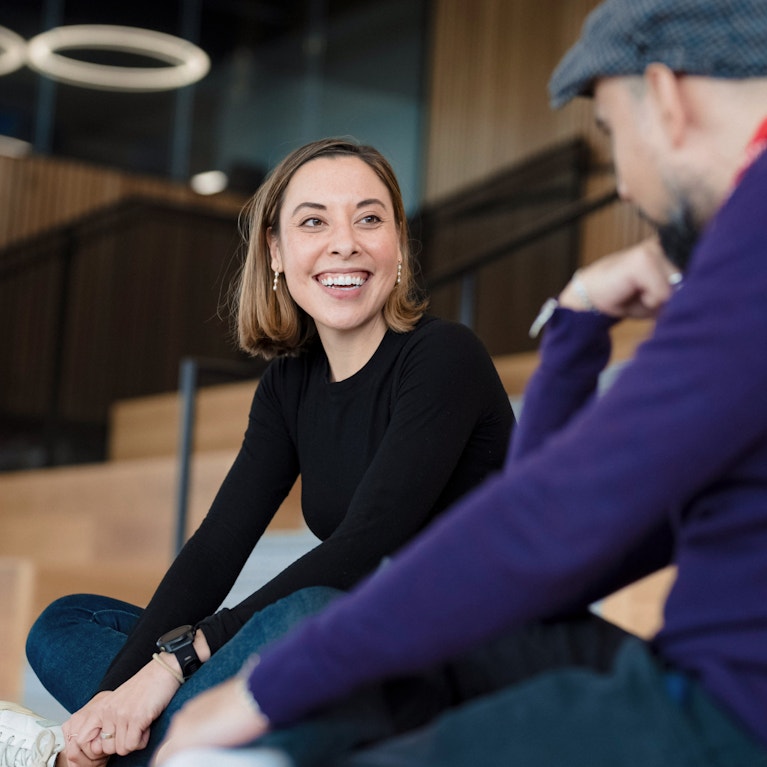
Big picture impact: Four insights from the 2024 CGF Global Summit in Chicago
Tags
In seminal 80s movie Ferris Bueller’s Day Off, one of the characters wanders off into the Museum of Modern Art in Chicago, before focusing his gaze on one particular piece. Gradually, as the camera switches between him and the painting, it tightens its focus on both. Finally, the picture is no longer meaningful, but reduced to a blur of pixels.
As leaders convened at the Consumer Goods Forum Global Summit 2024, which took place in Chicago 11 to 14 June, the film’s scene is a salient reminder that if those individual pixels can sometimes feel like they struggle for impact, together they help create a bigger picture. And that it’s this collective mass of action that can deliver real, visible sustainability progress.
Over three days in The Windy City, our team hosted a session on tackling the plastic challenge; discussed how leaders can deliver impact with speed, scale, and affordability; and came away with provocations and prompts for change.

Here are the key insights you need to know from the event:
1. Change calls for change agents
The Ferris Bueller scene above out plays out to the strains of “Please, Please, Please Let Me Get What I Want”, by The Smiths. For today’s consumer, what they want is a better, brighter, future. And this tallied perfectly with the Summit theme of ‘Empowering businesses to deliver a better tomorrow’.
Our recent Brand Impact Index study of US consumers found a significant shift in demand towards brands that are creating a better future for both their customers and the world at large: 84 percent of consumers told us they expect brands to do more than just make money; and 80 percent expect brands to demonstrate their commitment to people and profits. In this world, consumers are looking to brands to be responsible agents for change. It was a sentiment powerfully conveyed by 17-year-old food activist Molly Lewis, who exhorted attendees “to look after the health of future generations”.
The changing dynamics of consumer behaviour, and what they’re looking to spend on, is raising questions around what role manufacturers and retailers play in consumers’ daily lives. And keynote speaker Michelle Obama continued this theme, calling for food companies to come together and educate young children on healthy diet choices.
Crucially, our analysis found that the brands that create this brighter future grow faster, and can charge more for their products and services. We also found that sustainable approaches are one of the key pillars for brand success – with the likes of Dawn, Plum Organics, and Patagonia scored strongly here by consumers. And we enjoyed conversations with leaders on how, while offsetting and remediation have their place, the best brands apply whole-lifecycle thinking from the outset.
2. Collaboration unlocks greater impact
Consumer goods leaders are alive to the need to move beyond plastic, but often struggle when it comes to delivering speed, scale, and affordability. Without these key components, sustainability efforts will flounder – especially with the likelihood that plastic will be the next controlled substance – tracked, traced, taxed, and regulated.
In our special session, we set out the need for a model that allows for collaboration while still leaving space for first mover advantage. One key aspect of this is the idea of one party taking radical ownership of the entire problem – brands, suppliers, technology owners, and the larger ecosystem, both upstream and downstream.

We were delighted to be joined on stage by a range of experts in this space: Allison Lin, Global VP of Packaging Sustainability at Mars; Claudine Patel, Chief Marketing Office, Sanofi Consumer Healthcare; and Michael Goltzman, SVP Global Policy and Sustainability, Coca-Cola. Together with our in-house experts, the discussion centred on how global players are collaborating to curb investment risk and activate the larger ecosystem to tackle the plastics challenge.
As we discussed with delegates, major platform transformations are also needed to enable leaders to share information openly and embrace new technologies in a risk-controlled way. This will create the speed and power to push for true scale and deliver impact now. And our thoughts were echoed in a speech by CGF Board Co-Chairs Frans Muller, President & CEO of Ahold Delhaize, and Dirk Van de Put, Chairman & CEO of Mondelēz International, who talked about ‘elephants in the room’ that may feel tough to tackle, but which the industry can solve by working together.
3. Feeling the difference
It often feels like people have been talking about tackling the plastics challenge and sustainability issues for decades. And progress can feel particularly slow when it comes to collaborative action, which is often seen as cumbersome, chaotic, and – by the more cynical – as a convenient way for brands to signal action without deep-seated commitment.
Yet the Summit brought tangible evidence of the impact of new collaboration models – in the examples given by leaders given in our sessions, and also in the types of packaging available to people to touch and feel.
One of these were the recently announced commercial prototype Baileys Original Irish Cream Liqueur mini bottles, from Diageo – produced as part of the PA and PulPac Bottle Collective. It’s a Dry Molded Fiber (DMF) paper bottle made from sustainably sourced plant fibres, which not only saves water and energy during the manufacturing process, but is commercially viable, scalable, and adaptable to deliver the brand identities that consumers expect. And we’ve done something similar with the PulPac Blister Pack Collective.
All in all, it left a sense from the Summit that leaders want to go faster, and are now working together to maximise the impact they achieve.
4. Getting closer to consumers
Another recurring theme through our time in Chicago was the need for brands to keep innovating, and to become ever-closer to consumers. And that it’s those who use data and technology to continuously sense consumer needs and respond in real-time who have the edge.
It’s a recognition that generic personas won’t cut it, and that B2C has become ‘B2Me’. As Richard Taylor, Managing Director, Consumer and Consumer Health, Jefferies, set out: “The idea that the way you consume a product is exactly the same as somebody else — that’s anathema to the younger consumer; they don’t understand it. So personalisation is going to be really important.”
In response, the best brands embrace breakthrough technologies such as AI to unlock new possibilities and business-critical insights, enabling brands’ transformations from digital to intelligent enterprises. Nowhere was this more evident than in the Summit ‘store tours’, which took in AI-powered shopping experiences at Amazon Go, as well as in the demonstration of Project Astra, a virtual assistant under development by Google.
A number of visions of the future were shared, from groceries delivered by drone to high-rise windows, to pilotless freight planes, and shelf-stocking robots that can detect spills. Yet much of the talk centred around how AI can move from a buzzword to actual benefits. One example we shared with delegates was where we helped a food and beverage client use AI to optimise hot drink production. Using an online learning algorithm to analyse live beverage demand data, the client was able to minimise physical waste from production and associated energy consumption. This not only boosted profitability, but also reduced Scope 1 and 2 emissions. And that’s just the start of it.
Summary
As Rina Ladva, our Global Head of Alliances, outlined in our session, “We collectively have great power and responsibility…. And our conversations at this Summit show how many people have made deep commitments towards this future.”
In a sense, it’s encouraging that so many people have zoomed in on solutions. Yet our overriding sense was of the impact that can be achieved, and accelerated, by zooming out a little: to achieve material impact through collaboration by moving from the pixel to the bigger picture.
Explore more







